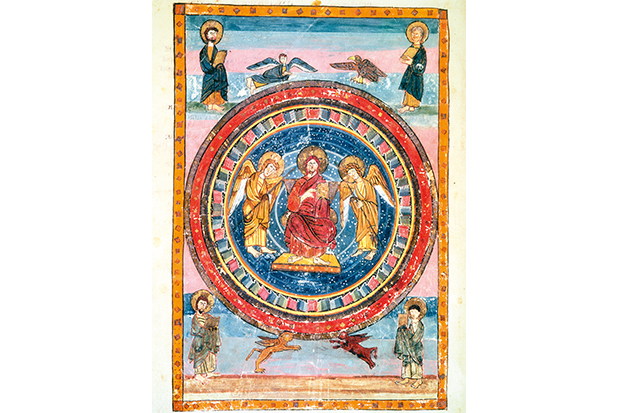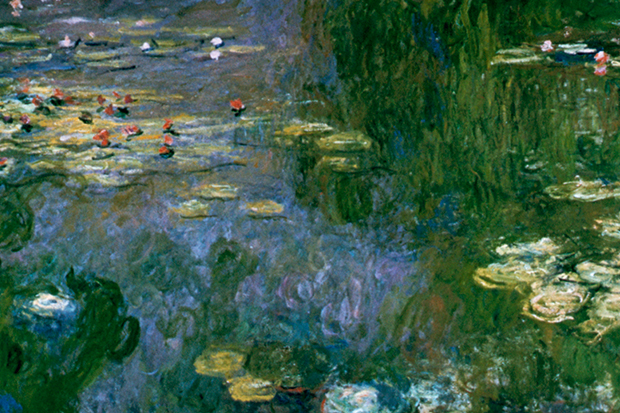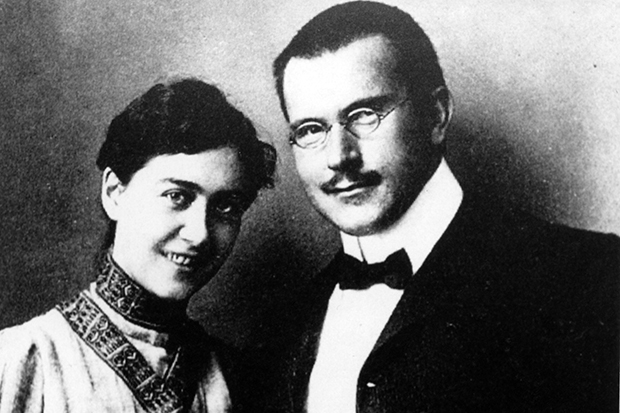The illustrated manuscripts of the European Middle Ages are among the most beautiful works to survive from a maligned and misrepresented age. The darkest of the Dark Ages produced the Book of Kells and the Lindisfarne Gospels. Out of the most vicious period of France’s medieval history emerged the exquisite books of hours painted by the Limbourg brothers for the repellent Duke of Berry. Yet, unlike the panel paintings, the sculpture, the buildings or the jewellery of the period, illustrated manuscripts are almost entirely inaccessible to the public. Light, oxygen and humidity, the three great enemies of pictorial artefacts, are especially unkind to manuscripts. Vellum is made of animal skin, which naturally decays. Vege-table dyes fade. Mineral pigments discolour.
And to these real dangers, modern librarians are apt to add imaginary ones, born of their firm conviction that even the world of scholarship is populated by vandals. The result is that most of these wonderful works are rarely shown, except in private to privileged persons of austere habits and unimpeachable expert credentials, a treatment that respectable libraries used to reserve for works of pornography.
One of these privileged persons is Christ-opher de Hamel. He has pursued his enthusiasm for medieval illustrated manuscripts ever since, as a teenager, he discovered the eclectic joys of the Reed Collection in Dunedin’s public library in his native New Zealand. After a quarter of a century working in the western manuscripts department of Sotheby’s, he finally found his natural niche in 2000 as fellow-librarian of Corpus Christi College, Cambridge and custodian of the college’s Parker Library, one of the greatest antiquarian manuscript collections in the world. He is one of the few people who can ask to handle a precious manuscript and expect its custodians to agree.
This is more than a courtesy due to status. As he points out, ‘No one can properly know or write about a manuscript without having seen it and held it in the hands.’ Facsimiles are no substitute. They provide a perfect image, deceptive, like everything perfect. They cannot convey the texture of vellum, the unevenness of the page, the depth of colour, the occasional awkwardness of the drawn line, the way the book has been made, the marks and scratches of the clerk and the bumptious additions of later generations.
Yet if we cannot see these things for ourselves, the next best thing is to be guided round them by Dr de Hamel. This is a guidebook to 12 of the most famous illustrated manuscripts in the world. It starts with the Gospels in the Parker Library, which were probably brought to England by St Augustine in 497 ad, at the outset of our Christian history, and concludes with the 16th-century Spinola Hours, which was rediscovered by Dr de Hamel himself in 1975 and is now in the Getty Museum. In between, we are taken on a world tour of manuscript depositories from Dublin to Munich, Copenhagen to Florence and New York to St Petersburg.
De Hamel writes in what I would call the Companion Guide chatty style. Anyone who has used J.G. Links’s guide to the paintings and coffee bars of Venice will know what I mean. ‘Come in — really,’ he bids us, as we stand in front of the Royal Library in Copenhagen. ‘Keep your voices down,’ he urges, once we are inside. Allow me to introduce the current curator Dr Petersen (‘thin shaggy fair hair and little glasses’). Much better than the Amazonian receptionist of the Russian National Library (‘resembled the late Mrs Khrushchev’) or the fierce prefects of the Pierpont Morgan Library (‘exquisitely crafted fair hair… expensively dressed’) who would not let Dr de Hamel adjust his own reading stand or lift a manuscript from the table. ‘At this point,’ he suggests, ‘let us take a break for lunch.’
If all this sounds eccentric, that is because it is. But there is nothing patronising about Dr de Hamel’s chattiness. Nor is it just pointless embellishment. For he has undertaken an almost impossible task. Instead of guiding our own exploration of these beautiful objects, his book has to serve as a substitute for the real thing. In this, he succeeds brilliantly, producing a truly wonderful book in the process — wise, entertaining and informative. There are many fine accounts of medieval manuscripts by notable scholars, but they are, on the whole, addressed to other scholars. None of them conveys so well to an amateur the atmosphere of a great manuscript depository, the excitement of discovery or the impression which the painted page can make on someone who is able to hold it in his hands.
At the same time, he provides the historical and artistic context which explains why this is worth doing. Beneath his urbane manner, Christopher de Hamel is a formidable scholar. He tells us about the texts and their authorship, as art historians rarely do. He covers the history of handwriting, of pigment and parchment-making, of binding and rebinding and of changing fashions in conservation. He discusses the shifting currents of taste and the infectious obsessiveness of the handful of men rich enough to collect medieval manuscripts. He takes us through the patient detective work required to establish the origin and history of these superb books. Recondite it may be, but some manuscripts have been revered as holy throughout their lives, and all of the ones discussed here have been coveted by collectors for centuries.
Some have seen more excitement than any of us ever will. Take, for example, the Visconti Semideus, a magnificently painted treatise on the art of war, looted from the ducal library of Milan after the French conquest of 1499, seized by the agents of the French Revolution from the famous Parisian library of the Abbey of St Germain-des-Près, stolen by the unscrupulous secretary of the Russian embassy in Paris and finally sold to the emperor of Russia along with 700 other precious manuscripts of equally questionable provenance.
Or the exquisite Hours of Jeanne de Navarre, created for a French princess and passed through generations of royalty, before being acquired by successive millionaires in England and France. The manuscript was stolen by Marshal Goering from the French Rothschilds in 1940 and disappeared, only to be rediscovered by accident nearly 30 years later. It had fallen from the special train used to transport Goering’s stolen hoard to Berchtesgarten in 1945. A French soldier picked it up after treading on it at a railway siding, took it home in his backpack, and gave it to a monastery in his native Brittany. The monks had no idea what it was until they tried to sell it in 1967 to repair their leaking roof. Baron Edmond de Rothschild, reunited with his property, is said to have asked the abbot how much it would cost to repair his roof, to have promptly written out a cheque for that amount, and then to have presented the book to the French national library, observing that he no longer had the time to read devotional works. It is now ‘Paris Bibliothèque Nationale MS n.a. lat 3145,’ says Dr de Hamel, ‘and we are going to see it.’
Except, of course, that we are not going to see it, and there’s the rub. It poses a challenging question of human psycho-logy. Why do we conserve artefacts in public collections which under modern curatorial principles the public cannot enjoy? Illustrated manuscripts are an inherently elitist pleasure. They were created for the leisured enjoyment of religious communities, princes and connoisseurs. They are incapable of being enjoyed in any other way, except vicariously through a handful of scholars and educators like Christopher de Hamel. Such works mock the whole concept of public ownership. Their possession by national institutions is simply a means of ensuring the physical conservation of objects which cannot be properly displayed, but whose mere existence has become an end in itself.
Like the caves of Lascaux, closed to the public indefinitely, illustrated manuscripts have become a public good in another sense. They are the unseen bodies of our artistic saints. We are all, apart from Dr de Hamel, participating in the modern equivalent of relic-worship.
The post Come in, but keep your voices down appeared first on The Spectator.
Got something to add? Join the discussion and comment below.
Get 10 issues for just $10
Subscribe to The Spectator Australia today for the next 10 magazine issues, plus full online access, for just $10.
You might disagree with half of it, but you’ll enjoy reading all of it. Try your first month for free, then just $2 a week for the remainder of your first year.














Comments
Don't miss out
Join the conversation with other Spectator Australia readers. Subscribe to leave a comment.
SUBSCRIBEAlready a subscriber? Log in